Abstract
Tenascin is an extracellular matrix glycoprotein that is not present in the normal mature rat mammary gland. The distribution of tenascin was examined by immunohistochemistry in mammary tumors from carcinogen-treated and untreated rats, in virus-induced mammary tumors from mice, and in a variety of mammary gland lesions from humans. Tenascin was detectable in the stroma of the malignant but not of the benign tumors from all species. An inhibition ELISA, testing homogenates of rat tumors, confirmed that tenascin was present in malignant but not in benign tumors. Thus, tenascin was consistently found to be a stromal marker for epithelial malignancy in the mammary gland. It is concluded that tenascin may be involved in the interactions between the epithelial and mesenchyme-derived (stromal) components of the mammary gland, which are known to influence epithelial carcinogenesis in this organ.
Full text
PDF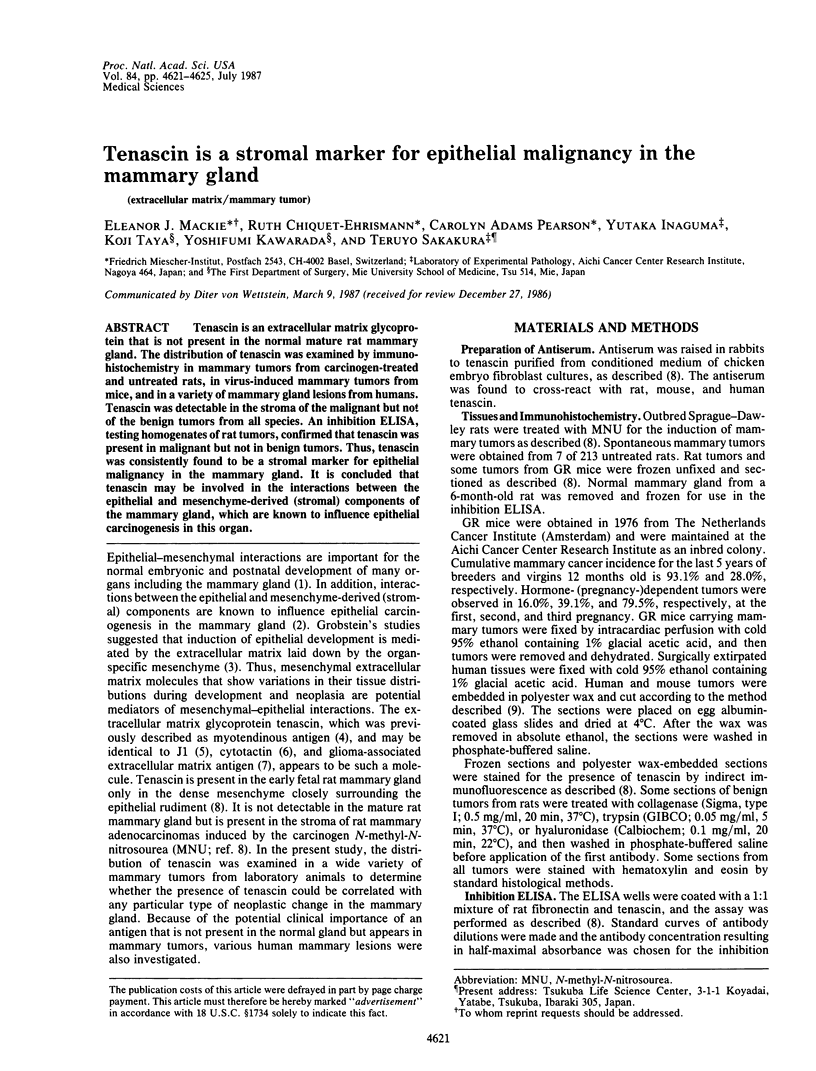
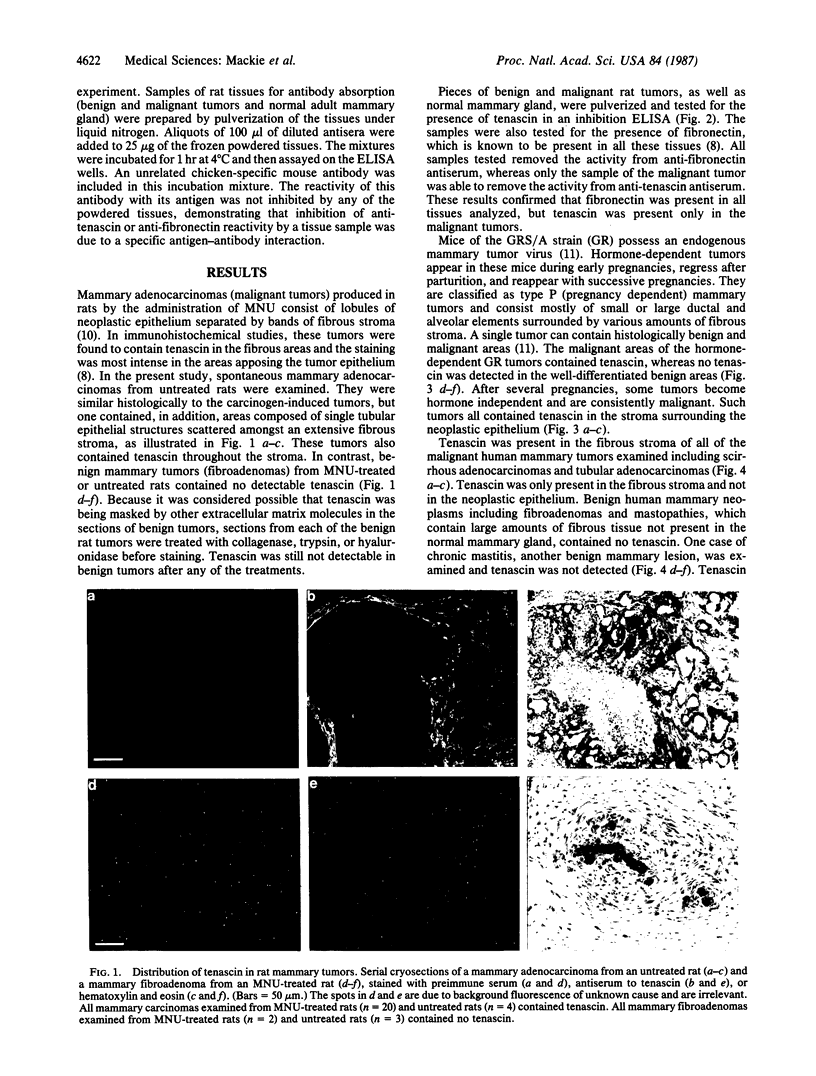
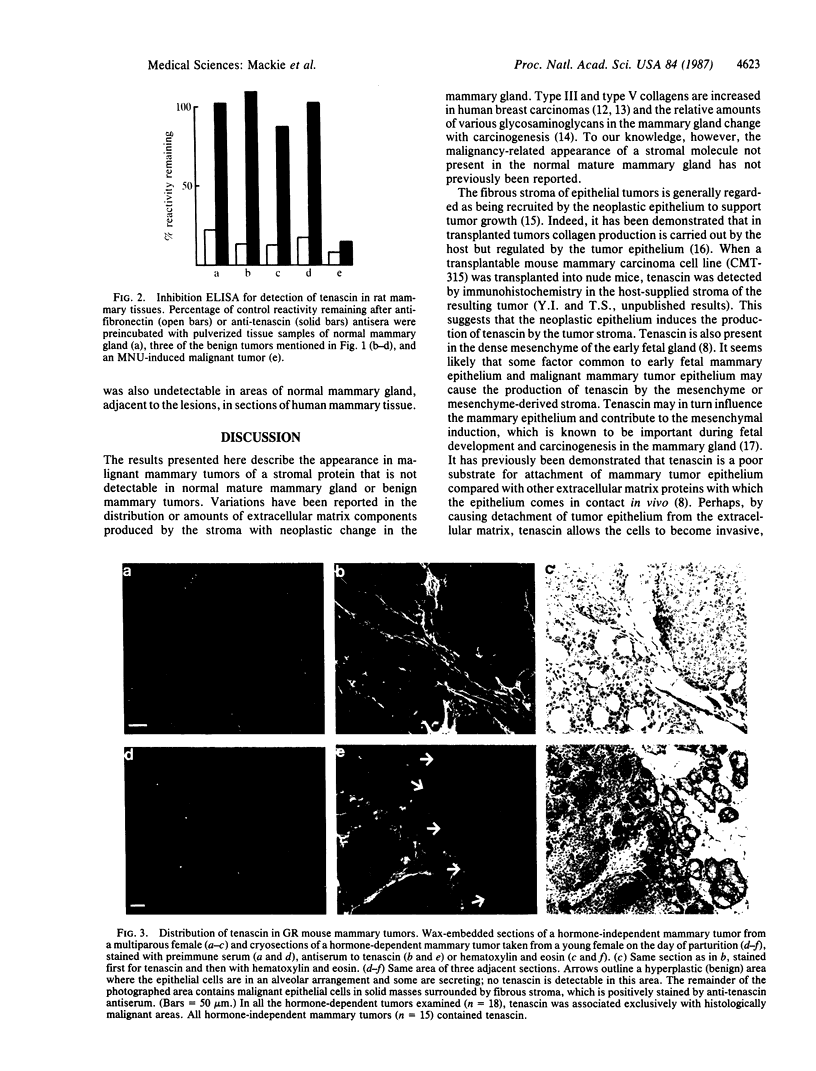
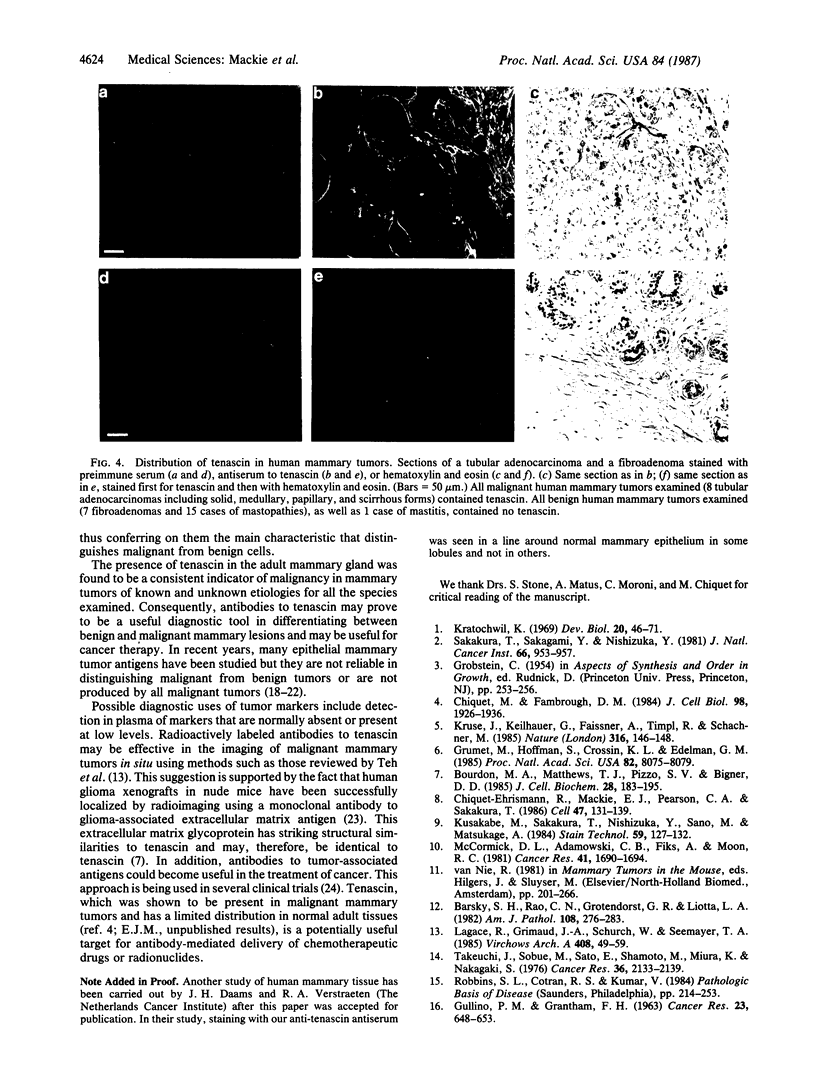
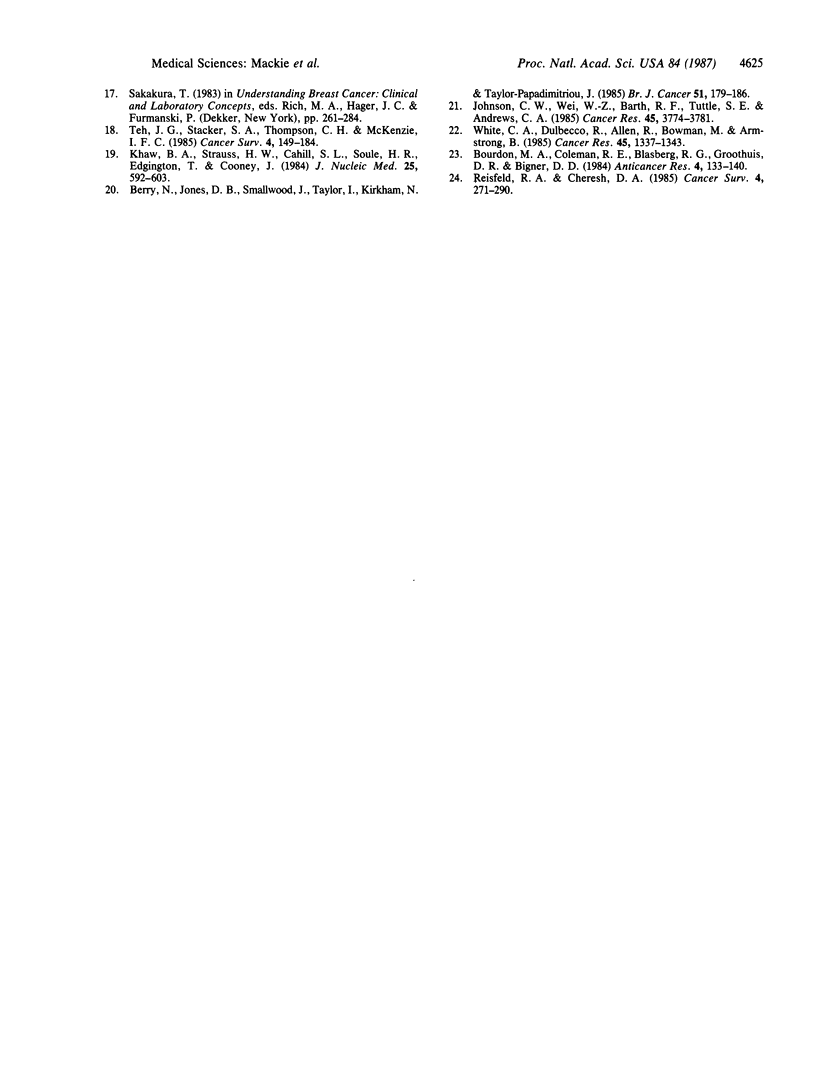
Images in this article
Selected References
These references are in PubMed. This may not be the complete list of references from this article.
- Barsky S. H., Rao C. N., Grotendorst G. R., Liotta L. A. Increased content of Type V Collagen in desmoplasia of human breast carcinoma. Am J Pathol. 1982 Sep;108(3):276–283. [PMC free article] [PubMed] [Google Scholar]
- Berry N., Jones D. B., Smallwood J., Taylor I., Kirkham N., Taylor-Papadimitriou J. The prognostic value of the monoclonal antibodies HMFG1 and HMFG2 in breast cancer. Br J Cancer. 1985 Feb;51(2):179–186. doi: 10.1038/bjc.1985.27. [DOI] [PMC free article] [PubMed] [Google Scholar]
- Bourdon M. A., Coleman R. E., Blasberg R. G., Groothuis D. R., Bigner D. D. Monoclonal antibody localization in subcutaneous and intracranial human glioma xenografts: paired-label and imaging analysis. Anticancer Res. 1984 May-Jun;4(3):133–140. [PubMed] [Google Scholar]
- Bourdon M. A., Matthews T. J., Pizzo S. V., Bigner D. D. Immunochemical and biochemical characterization of a glioma-associated extracellular matrix glycoprotein. J Cell Biochem. 1985;28(3):183–195. doi: 10.1002/jcb.240280302. [DOI] [PubMed] [Google Scholar]
- Chiquet-Ehrismann R., Mackie E. J., Pearson C. A., Sakakura T. Tenascin: an extracellular matrix protein involved in tissue interactions during fetal development and oncogenesis. Cell. 1986 Oct 10;47(1):131–139. doi: 10.1016/0092-8674(86)90374-0. [DOI] [PubMed] [Google Scholar]
- Chiquet M., Fambrough D. M. Chick myotendinous antigen. I. A monoclonal antibody as a marker for tendon and muscle morphogenesis. J Cell Biol. 1984 Jun;98(6):1926–1936. doi: 10.1083/jcb.98.6.1926. [DOI] [PMC free article] [PubMed] [Google Scholar]
- GUILLINO P. M., GRANTHAM F. H. The influence of the host and the neoplastic cell population on the collagen content of a tumor mass. Cancer Res. 1963 May;23:648–653. [PubMed] [Google Scholar]
- Grumet M., Hoffman S., Crossin K. L., Edelman G. M. Cytotactin, an extracellular matrix protein of neural and non-neural tissues that mediates glia-neuron interaction. Proc Natl Acad Sci U S A. 1985 Dec;82(23):8075–8079. doi: 10.1073/pnas.82.23.8075. [DOI] [PMC free article] [PubMed] [Google Scholar]
- Johnson C. W., Wei W. Z., Barth R. F., Tuttle S. E., Andrews C. A. Monoclonal antibodies directed against preneoplastic and neoplastic murine mammary lesions. Cancer Res. 1985 Aug;45(8):3774–3781. [PubMed] [Google Scholar]
- Khaw B. A., Strauss H. W., Cahill S. L., Soule H. R., Edgington T., Cooney J. Sequential imaging of indium-111-labeled monoclonal antibody in human mammary tumors hosted in nude mice. J Nucl Med. 1984 May;25(5):592–603. [PubMed] [Google Scholar]
- Kratochwil K. Organ specificity in mesenchymal induction demonstrated in the embryonic development of the mammary gland of the mouse. Dev Biol. 1969 Jul;20(1):46–71. doi: 10.1016/0012-1606(69)90004-9. [DOI] [PubMed] [Google Scholar]
- Kruse J., Keilhauer G., Faissner A., Timpl R., Schachner M. The J1 glycoprotein--a novel nervous system cell adhesion molecule of the L2/HNK-1 family. Nature. 1985 Jul 11;316(6024):146–148. doi: 10.1038/316146a0. [DOI] [PubMed] [Google Scholar]
- Kusakabe M., Sakakura T., Nishizuka Y., Sano M., Matsukage A. Polyester wax embedding and sectioning technique for immunohistochemistry. Stain Technol. 1984 May;59(3):127–132. doi: 10.3109/10520298409113845. [DOI] [PubMed] [Google Scholar]
- Lagacé R., Grimaud J. A., Schürch W., Seemayer T. A. Myofibroblastic stromal reaction in carcinoma of the breast: variations of collagenous matrix and structural glycoproteins. Virchows Arch A Pathol Anat Histopathol. 1985;408(1):49–59. doi: 10.1007/BF00739962. [DOI] [PubMed] [Google Scholar]
- McCormick D. L., Adamowski C. B., Fiks A., Moon R. C. Lifetime dose-response relationships for mammary tumor induction by a single administration of N-methyl-N-nitrosourea. Cancer Res. 1981 May;41(5):1690–1694. [PubMed] [Google Scholar]
- Reisfeld R. A., Cheresh D. A. Human tumour-associated antigens: targets for monoclonal antibody-mediated cancer therapy. Cancer Surv. 1985;4(1):271–290. [PubMed] [Google Scholar]
- Sakakura T., Sakagami Y., Nishizuka Y. Accelerated mammary cancer development by fetal salivary mesenchyma isografted to adult mouse mammary epithelium. J Natl Cancer Inst. 1981 May;66(5):953–959. [PubMed] [Google Scholar]
- Takeuchi J., Sobue M., Sato E., Shamoto M., Miura K. Variation in glycosaminoglycan components of breast tumors. Cancer Res. 1976 Jul;36(7 Pt 1):2133–2139. [PubMed] [Google Scholar]
- Teh J. G., Stacker S. A., Thompson C. H., McKenzie I. F. The diagnosis of human tumours with monoclonal antibodies. Cancer Surv. 1985;4(1):149–184. [PubMed] [Google Scholar]
- White C. A., Dulbecco R., Allen R., Bowman M., Armstrong B. Two monoclonal antibodies selective for human mammary carcinoma. Cancer Res. 1985 Mar;45(3):1337–1343. [PubMed] [Google Scholar]




















